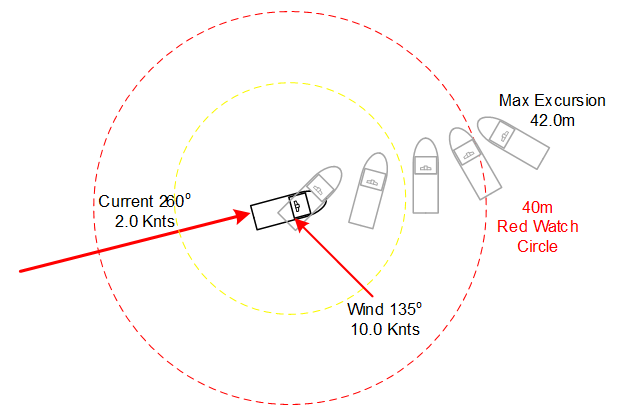Consequences of Decisions – Heading Change left too late
Case narrative:
A DP2 vessel was conducting drilling operations and connected via the riser to the well in 2000m water depth. The vessel was configured Closed Bus with four out of the six generators connected, six thrusters were selected into DP Control. Along with two DGNSS and one Hydro-acoustic PRS.
A strong current was running SW to NE at approx. 1.6knts, the vessel was orientated with the stern of the vessel into the oncoming direction of current.
The decision was made to re-orientate the vessel bow into the current which required a heading change of 180o , as per the ASOG this required going to blue (advisory) status, all relevant rig crew were informed and an extra engine was started and connected to the closed bus.
See illustration in Figure 2 below

As the heading change was executed, the bow thrusters ramped up to 100% and at 35o into the turn the vessel was already approaching the Yellow watch circle. Gains were adjusted in order to prioritise the heading. When the vessel was abeam of the current, the vessel speed was 0.7knts easterly and increasing, the vessel continued to move off the original position. By 35m off position, the speed of travel was seen to be decreasing. Upon reaching the Red watch circle the speed easterly was at 0.30knts and reducing.
The vessel passed through the Red watch circle and exceeded it by 2m before the vessel started to step back in and return to the original position.
20 minutes from initial heading change the vessel settled on the new heading and position.
Causal Factors:
Below is a list of causes that together led to the incident highlighted above:
- The decision making process – The parameters around the decision to make the move were not clear from the event report in terms of adherence to ASOG/WSOG, with regards the monitoring of environmental conditions and overall timing of the move.
- The environmental conditions at the time and prior to executing heading change.
- The power of the thrusters were unable to counter the environmental conditions which caused the vessel to breach the Red watch circle.
The Lessons:
The following lessons can be taken from this incident:
- Further risk assessment when undertaking this sort of vessel adjustment is crucial.
- The vessel breached the Red watch circle, this is the point where disconnecting was a stated act in the ASOG/WSOG.
- This event highlights the need for good operational planning and a detailed accurate ASOG/WSOG.
Consideration of the IMCA Marine DP Committee from the above event:
This event highlights the need for good operational planning and a detailed accurate ASOG/WSOG. Planning needs to include when DP vessels are operating in an increasing environmental condition or close to the fringes of the vessel’s capability. Considerations should include:
- What are my safe limits for heading or position moves and are these detailed in the ASOG/WSOG?
- What are my limits for safe disconnection (or time to terminate) in the case of being unable to maintain position / heading while also considering post worst case failure capability?
- Key personnel involved in the decision-making process.
- What are my limits for emergency disconnection in the event of loss of position?
- What was the Rate of Turn and acceleration values? This may have contributed to the rapid increase of thrust.
It is not clear from the event report if the decision support tools were available and robust enough to safely execute the heading change undertaken. Likewise, the report makes no reference to capability plots which should show limitations and DP footprint plots which can also provide guidance on the vessel’s maximum operational environment. IMCA M 103 – Guidelines for the design and operation of dynamically positioned vessels – refers to the use of DP footprint plots to record the vessel’s actual performance. These footprint plots, created on board, are of the vessel’s real station keeping performance in various thruster and vessel configurations and in different environmental conditions. IMCA M 140 – Specification for DP Capability Plots, and IMCA M 220 – Guidance on operational activity planning, can also be referenced.
The committee believe that a loss of position and heading should have been anticipated and therefore, serious consideration should have been given to securing the activities of the vessels industrial mission.
DP Event
Published: 13 December 2021
Download: IMCA DPE 04/21
Submit a Report
The following case studies and observations have been compiled from information received by IMCA. All vessel, client, and operational data has been removed from the narrative to ensure anonymity.
Case studies are not intended as guidance on the safe conduct of operations, but rather to assist vessel managers, DP operators and DP technical crew in appropriately determining how to safely conduct their own operations. Any queries should be directed to IMCA at [email protected]. Members and non-members alike are welcome to contact IMCA if they have experienced DP events which can be shared anonymously with the DP industry.
IMCA’s store terms and conditions (https://www.imca-int.com/legal-notices/terms/) apply to all downloads from IMCA’s website, including this document.
IMCA makes every effort to ensure the accuracy and reliability of the data contained in the documents it publishes, but IMCA shall not be liable for any guidance and/or recommendation and/or statement herein contained. The information contained in this document does not fulfil or replace any individual’s or Member's legal, regulatory or other duties or obligations in respect of their operations. Individuals and Members remain solely responsible for the safe, lawful and proper conduct of their operations.
